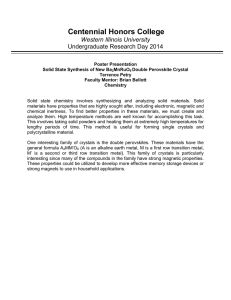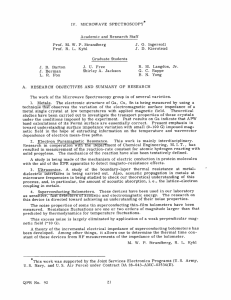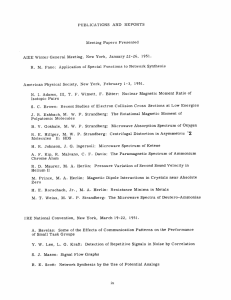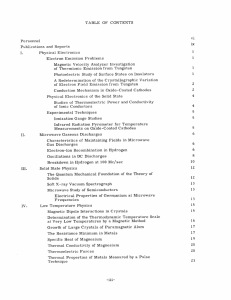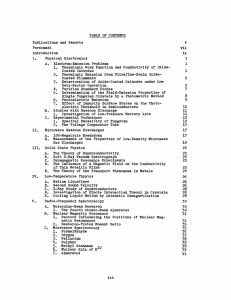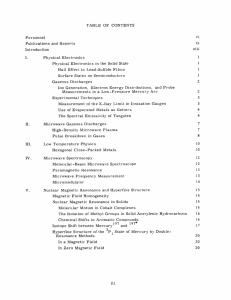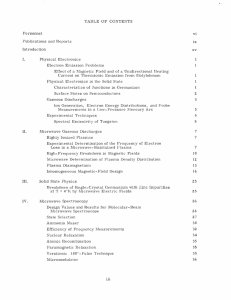IV. MICROWAVE SPECTROSCOPY Academic and Research Staff
advertisement
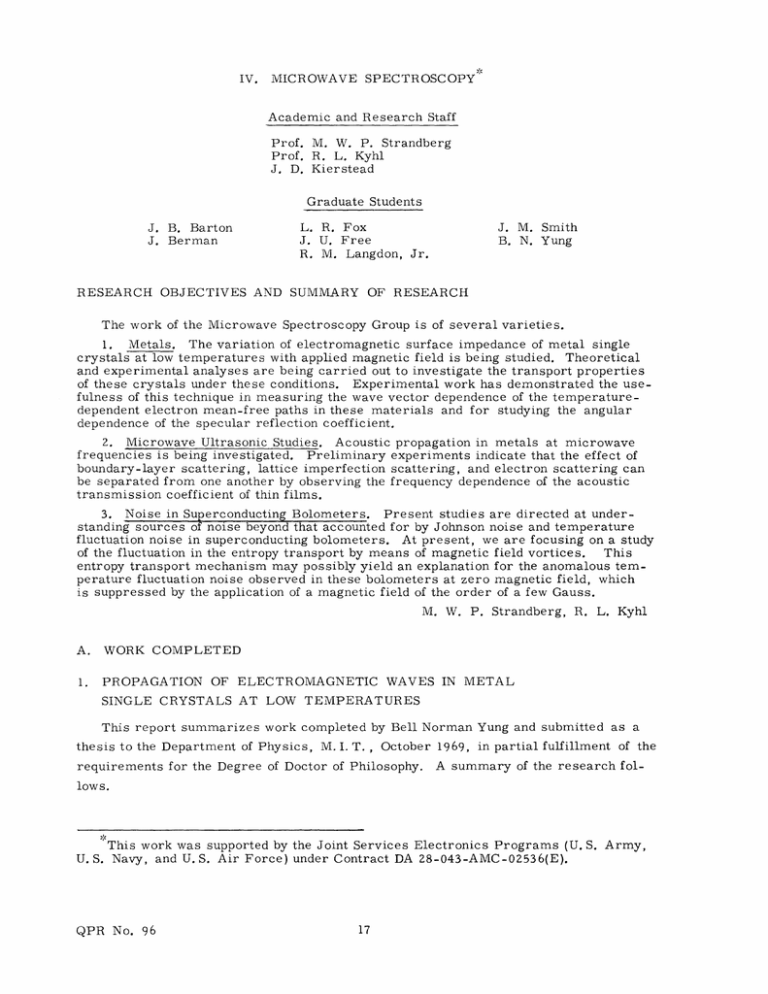
IV. MICROWAVE SPECTROSCOPY Academic and Research Staff Prof. M. W. P. Strandberg Prof. R. L. Kyhl J. D. Kierstead Graduate Students J. J. B. Barton Berman L. R. Fox J. U. Free R. M. Langdon, Jr. RESEARCH OBJECTIVES AND SUMMARY J. M. Smith B. N. Yung OF RESEARCH The work of the Microwave Spectroscopy Group is of several varieties. 1. Metals. The variation of electromagnetic surface impedance of metal single crystals at low temperatures with applied magnetic field is being studied. Theoretical and experimental analyses are being carried out to investigate the transport properties of these crystals under these conditions. Experimental work has demonstrated the usefulness of this technique in measuring the wave vector dependence of the temperaturedependent electron mean-free paths in these materials and for studying the angular dependence of the specular reflection coefficient. 2. Microwave Ultrasonic Studies. Acoustic propagation in metals at microwave frequencies is being investigated. Preliminary experiments indicate that the effect of boundary-layer scattering, lattice imperfection scattering, and electron scattering can be separated from one another by observing the frequency dependence of the acoustic transmission coefficient of thin films. 3. Noise in Superconducting Bolometers. Present studies are directed at understanding sources of noise beyond that accounted for by Johnson noise and temperature fluctuation noise in superconducting bolometers. At present, we are focusing on a study of the fluctuation in the entropy transport by means of magnetic field vortices. This entropy transport mechanism may possibly yield an explanation for the anomalous temperature fluctuation noise observed in these bolometers at zero magnetic field, which is suppressed by the application of a magnetic field of the order of a few Gauss. M. W. A. WORK COMPLETED 1. PROPAGATION OF ELECTROMAGNETIC P. Strandberg, R. L. Kyhl WAVES IN METAL SINGLE CRYSTALS AT LOW TEMPERATURES This report summarizes work completed by Bell Norman Yung and submitted as a thesis to the Department of Physics, M. I. T. , October 1969, requirements for the Degree of Doctor of Philosophy. in partial fulfillment of the A summary of the research fol- lows. This work was supported by the Joint Services Electronics Programs (U. S. Army, U. S. Navy, and U. S. Air Force) under Contract DA 28-043-AMC-02536(E). QPR No. 96 (IV. MICROWAVE SPECTROSCOPY) The radio-frequency surface impedance variations with a DC magnetic field, H, for metal single crystals in the anomalous skin-effect region were measured. Main interest lies in the observation of the real part of the surface impedance R S as a nonmonotonic function of small H. The data were investigated for a wide range of temperatures. An improved Pound-Knight-Watkins nuclear magnetic resonance spectrometer was employed for detecting the signal. A square-wave modulation technique was introduced. The resultant data were analyzed on a PDP-1 computer to yield R S as a function of H. Three different metals were investigated. from oriented seed crystals. Single crystals of gallium and tin were grown Experiments were performed for various crystal orienta- tions. Potassium samples were prepared in polycrystalline form. performed for various sample thicknesses. Experiments were All samples had dimensions 1 cm X 1 cm, with thickness varying from 0. 127 mm to 1 mm. The RF electric field and the DC mag- netic field were both applied parallel to the sample plane, and perpendicular to each other. Temperatures ranged from 1. 8°K to 10 0 K. Experimental results show interesting nonmonotonic behavior of R S with H. The signal characteristics are highly dependent on temperature. A simple model is proposed. Its specific behavior under different external conditions is discussed in order to interpret the experimental data. No mathematical rigor supports the arguments. The model satisfactorily explains several general features of the data but is unable to account for others, mainly because of a lack of detailed calculations. The reasonable magnitude of mean-free path derived from the model with the use of experimental data gives further evidence of the validity of the model. An angle-dependent specular reflection mechanism of electrons at the metal surface is assumed. The experimental result gives confirmation to this scheme. Similar experi- ments along the same line would be a promising avenue for further investigation and deeper understanding of the surface effects on electron dynamics. An integro-differential equation for the electric field distribution in a metal is derived. An attempt to obtain a solution by an iteration method that eventually proved futile is described. This work is not completely without value, however, since a kernel that is calculated from an approximately logarithmic nonlocal conductivity proves to be valid for obtaining the solution of the equation by another method. M. W. QPR No. 96 P. Strandberg
